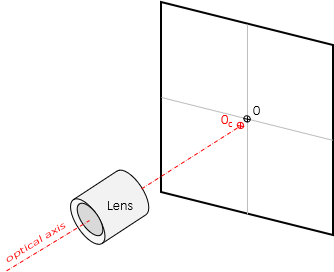3. Calibration
As with any measuring instrument, a camera is subject to instrumental errors. Aberrations and distortions are one group of errors. The fiducial marks are another: do the axes intersect at right angles? Does their intersection, Figure B-5, coincide with the principal point? Does the optical axis intersect the focal plane at right angles?
 |
| Figure B-5 Principal Point Calibration |
A camera calibration includes information to compensate systematic errors. These include geometric camera attributes (focal length, fiducial coordinates, principal point coordinates, etc) as well as lens distortion behavior. For example, the following is calibration data for a Wis DOT mapping camera.
| Camera Serial No. | 266611B |
| Focal length | 152.2650 mm |
| Principal point x | -0.0020 mm |
| Principal point y | -0.0040 mm |
Fiducial coordinates

| Side | x, mm | y, mm | Corner | x, mm | y, mm | |
| A | -112.0120 | 0.0030 | E | -110.0080 | 110.000 | |
| B | -0.050 | 111.9850 | F | 109.9950 | 109.9920 | |
| C | 111.9940 | -0.0030 | G | 109.9930 | -110.000 | |
| D | -0.0040 | -111.9950 | H | -110.0080 | -110.000 |
Although basic ground information can be determined using an image and general camera data, more accurate results are possible with calibration data.
Performing a camera calibration is beyond the scope of the material presented herein. Any photogrammetry text will have an extensive discussion of calibration processes as well as use of the data.